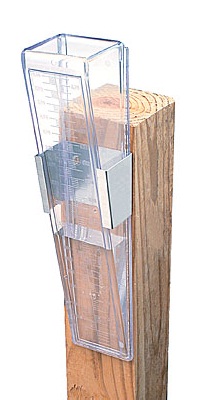 Home Weather Stations - January 2, 2013 Jeff Schalau, Agent, Agriculture & Natural Resources University of Arizona Cooperative Extension, Yavapai County Northern Arizona residents know that our weather is highly variable, even across very short distances. Weather prediction technology continues to improve, but we simply have too many variables to correctly predict the weather all the time. We also know that weather is important to plant growth and monitoring it can make us better gardeners. A rain gauge (precipitation gauge) and maximum/minimum (max/min) thermometer are the two most useful weather instruments for gardeners. They are simple and relatively inexpensive. Basic rain gauges come in two designs. The "round" type consists of a clear plastic cylinder with graduated marks to indicate the volume (depth) of rainfall in inches or centimeters. The "tapered" types are wedge-shaped and have the graduated marks on a flat surface (I prefer this design). In both types, the collection area is larger than the storage area. This serves two purposes (1) to increase the sampling area such that a representative sample is collected, and (2) to make the graduated marks farther apart so that an accurate reading can be observed. Proper installation of your rain gauge is critical. The bracket of the gauge should be fastened to an upright post that allows the gauge to sit above the ground. The top of the gauge should be 5 inches above the top of the post. The gauge should sit firmly in the mounting bracket. Placement should be away from any buildings, trees, walls or other tall objects that could bias readings. On remote sites such as rangeland pastures, a simple rain gauge can be constructed of a 30-inch length of 2 inch PVC pipe. A PVC cap is glued onto one end. The pipe is then hose clamped open-end-up to a fence post. Small volumes (1 inch) of antifreeze and a covering of oil or automatic transmission fluid (ATF) are put into the pipe and a baseline measurement is taken with a measuring tape. Any precipitation entering the pipe will mix with the antifreeze and remain a liquid even during freezes. When visiting the site, depth readings are taken, giving the amount of precipitation since the last reading. The oil or ATF floats on top of the water and antifreeze preventing evaporation. This type of rain gauge should be cleaned and replenished at least once per year. It is also a good idea to put a piece of hardware cloth inside the opening to prevent birds, rodents, and other small animals from entering the pipe. Max/min thermometers also come in different designs. The standard type is either mercury or alcohol filled and tracks the maximum and minimum temperature since the last time the instrument was reset. Daily resetting will give the previous day's max and min temperatures. Place your outdoor max/min thermometer out of direct sunlight and near the area that you are concerned with monitoring (i.e. your orchard or garden). Electronic max/min thermometers are widely available for reasonable prices (around $40). These instruments usually have sensors for indoor and outdoor locations. Some come with alarm systems to warn when temperatures dip below or above a given set point. Most now have wireless sensors that transmit signals for 100 feet and the battery life is two years or more. Many models are also available with hygrometers to measure humidity and barometers to monitor atmospheric pressure. Some models can be set up for multiple wireless sensors. For those wanting more information, home weather stations are available with anemometers, tipping bucket rain gauges, and computer interfaces that transfer data to your personal computer (between $100 - $300 depending on features). Avid gardeners should seriously consider putting in a rain gauge and max/min thermometer. If nothing else, weather makes for great conversation. Finally, keep a journal to record your weather observations. Better yet, become a citizen scientist and share your precipitation data with others via the rainlog.org website. Register for this University of Arizona project and you can view interactive maps, store precipitation data for your location, and compare with other rainloggers. It’s fun and you will be providing data for climate research projects. Follow the Backyard Gardener on Twitter – use the link on the BYG website. If you have other gardening questions, call the Master Gardener help line in the Camp Verde office at 928-554-8999 Ext. 3 or e-mail us at cottonwoodmg@yahoo.com and be sure to include your name, address and phone number. Find past Backyard Gardener columns or provide feedback at the Backyard Gardener web site: http://cals.arizona.edu/yavapai/anr/hort/byg/. |